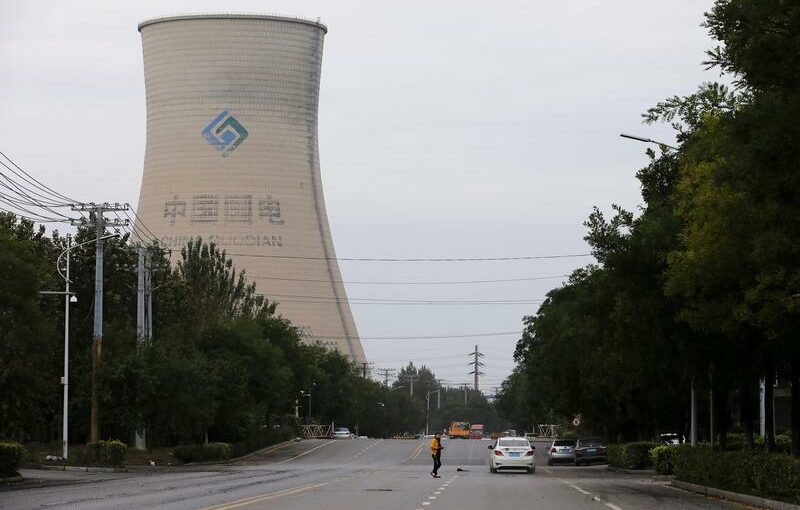BEIJING (Reuters) – China’s imports of coal surged by 76% in September as power plants scrambled for fuel to ease a power crunch that is pushing domestic coal prices to record highs and disrupting business activity in the world’s second-largest economy.
Flooding in a key coal producing province has worsened the supply outlook, with electricity shortages and rationing expected to continue into early next year.
China, the world’s largest coal consumer, has been grappling with a growing energy crisis brought on by shortages and record high prices for the fuel. The government has taken a range of steps to boost coal production and manage electricity demand at industrial plants, while power producers and other coal users have been ramping up imports.
On Tuesday, the government took its boldest step in a decades-long power sector reform by allowing coal-fired power plants to pass on the high costs of generation to some end-users via market-driven electricity prices, adding to worries about building global inflationary pressures.
Data on Wednesday showed China’s coal imports last month rose to their highest so far this year.
Imports totalled 32.88 million tonnes in September, up 76% from a year earlier, data from the General Administration of Customs showed. The monthly tally was the fifth highest on record, according to Reuters calculations.
Graphic: China monthly coal imports since 2015
Local governments in top Chinese coal producing areas Shanxi and Inner Mongolia have ordered some 200 mines to boost output, but incessant rain has flooded 60 mines in Shanxi. Four mines with a combined annual output capacity of 4.8 million tonnes remained shut, a Shanxi official told a news conference on Tuesday.
Graphic: Flooding in northern China
The most-active January Zhengzhou thermal coal futures touched a record of 1,640 yuan ($254.44) per tonne in Wednesday trade, having surged almost three-fold year-to-date.
The rise in prices comes a day after Beijing announced it would allow power plants to charge here commercial customers market-based prices for power, in a significant break from previous policy that allowed industry to lock in fixed-price power deals with suppliers.
The policy shift, which is expected to spur more coal-fired generation, is the latest in a raft of measures designed to ease the power crunch that has forced several industry sectors in China to curb power use and production in recent weeks.
Power-hungry industries such as steel, aluminium, cement and chemical producers are expected to face higher and more volatile power costs as previous fixed-cost arrangements are replaced by market-based pricing. [L1N2R904N]
Despite the disruptions, data on Wednesday showed overall export growth from the world’s second-largest economy unexpectedly accelerated in September, as solid global demand offset some of the pressures on factories from power shortages and other issues.
“Although power rationing doesn’t appear to have derailed the export sector so far, there is still a risk that it could do so in the coming weeks,” Julian Evans-Pritchard, Senior China Economist at Capital Economics said in a note.
“And while officials have made clear that the focus of power rationing will be energy-intensive sectors such as metals and chemicals, the hit to output in these industries could filter through supply chains and hurt downstream exporters.”
The country, the world’s biggest steel producer, on Wednesday told steel mills in 28 cities to cut winter output by at least 30% to achieve output and climate goals.
The European Chamber of Commerce said that some European firms operating in China are facing delays in orders while some others are unhappy about how Chinese authorities notify them about power cuts sometimes late into the night.
COAL IMPORTS RISE
China’s mammoth industrial engine, which cranks out mountains of electronics, toys, clothes and equipment for global markets, saw total power consumption in September and year to date rise year-on-year.
Electricity consumption in September rose 6.8% from a year earlier 694.7 billion kilowatt hours (kwh), bringing total power use over the first nine months up by 12.9% year-on-year, the National Energy Administration said on Wednesday.
China is not the only nation struggling with power supplies, which has led to fuel shortages and blackouts in some countries. The crisis has highlighted the difficulty in cutting the global economy’s dependency on fossil fuels as world leaders seek to revive efforts to tackle climate change at talks next month in Glasgow.
Reuters reported last week that China has been releasing Australian coal from bonded storage but hasn’t lifted an almost year-long, unofficial import ban on the fuel.
Exports from other key suppliers, such as Russia and Mongolia, have been curtailed by limited rail capacity, while shipments from Indonesia have been hindered by rainy weather, traders said.
Power plants are also seeking to diversify coal sources from niche markets such as Kazakhstan.
China’s energy crisis is expected to last into winter, with analysts and traders forecasting a 12% drop in industrial power consumption in the fourth quarter as coal supplies fall short and local governments give priority to residential users.
($1 = 6.4455 Chinese yuan renminbi)
Source: Read Full Article
